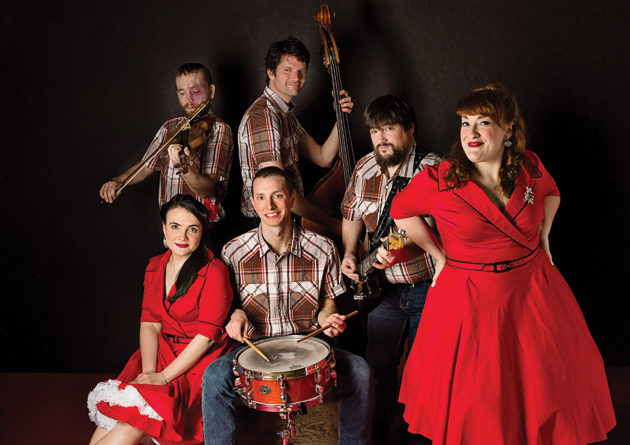Behind the Scenes with Thérèse LaGamma – Why We’re Sweet on The Sweetback Sisters

TL: Why “Sweetback Sisters” – where does the name come from?
EM: We started the band as just the two of us girls, so we thought we would tip our hats to the brother and sister duets of the fifties and sixties by taking “Sisters” as part of our name. The “Sweetback” part came from when we were looking on a website of hobo slang from the 1940s. The term “Sweetback” referred to someone who was just sampling the hobo life. We liked the alliteration, and it also seemed like an apt metaphor for the musician’s life. We hired the four boys before our first gig, but the name stuck. They don’t seem to mind being in a Sister band.
TL: You have described yourselves as a “renegade retro” band. What is there about your personalities and your music that makes you renegades?
EM: Country music from the 1940s, 50s and 60s is some of my favorite music that’s ever been made. We totally love listening to Ray Price, George Jones, Patsy Cline, Kitty Wells, The Maddox Brothers & Rose, and all the great artists who recorded in that era. And because of that love, we incorporate much of that sound into our songs—that’s the retro part. But at the same time, we don’t shy away from distortion in the electric guitar, rock beats on the drums, and wacky instrumental jams—that’s the renegade side.
TL: Who is the yodeler in the group and what’s your favorite thing about yodeling?
EM: Zara and I both yodel. In fact, we do a little bit of harmony yodeling in our shows, which is very satisfying! I grew up singing country music with my family, and learned at a young age that one of the most important tools in a country singer’s toolkit is her voice break. I use my break in almost every song I sing, even if it doesn’t have a traditional yodeling solo in it. Hank Williams was the king of that integrated yodeling technique and I just love that raw sound. I guess that’s why I’m a country singer instead of singing Wagner or something like that.
TL: Where do most of your songs come from? Do you all contribute to the songwriting process?
EM: Our original songs come from almost all of the members of the band. On the latest record, for example, there are songs from four out of the six of us. Jesse Milnes, our fiddler, is the most prolific writer. He seems to come up with an awesome new song once every couple of weeks. As for our process, we like to write the songs—the lyrics and melody—individually and then bring that basic form to the band to arrange. Some of that arranging happens in rehearsals, and some just happens spontaneously during our shows. When something cool happens—a nice groove, an extended solo, an unexpected harmony—we try to remember that and keep it as part of the arrangement of the song. The same goes for cover songs. We cut our teeth on classic country music and still love to play songs from the country artists that we admire. Of course, we like to put our own spin on them and a lot of that character is developed in our live shows.
TL: What surprises do you have in store for folks coming to see you in July?
EM: I don’t want to give away too many surprises! We have some great new songs in the works, though, that should debut in our live shows this summer.
Check out their amazing live performance from Shrewsbury Folk Festival in the U.K.:
One of their influences: Jimmie Rodgers: Blue Yodel No. 1 (T for Texas)
